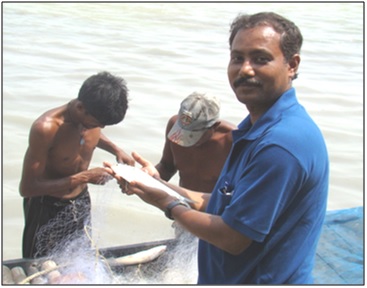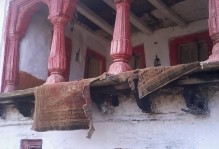
Dwindling Catch of Hilsa Endangers Bengali Cuisine

Dr Ashim Kumar Nath, one of India’s foremost experts in Hilsa fishery, speaks of going beyond technology. His stress is on involving the Hilsa fishermen for conserving the Hilsa.
There are old Bengali sayings- Maache Bhaate Bangali (fish and rice makes a Bengali) and Maacher Raja Ilish (King of Fish is Hilsa). Together they exemplify Bengali’s almost fanatical love for fish and partiality for Hilsa or Ilish.  A Bengali man is considered uninitiated if he cannot negotiate the sludge of the fish market, zero in on the best Ilish, lift the kanko (gills) to check on the freshness , haggle the price and bring back as a triumphant trophy, the Ilish maach, to his beaming wife. And while handing the fish advice her “shob ta aaj raana koro na†(Do not cook all of it today) - Hilsa is too good to be eaten at one go, it needs to be cooked in batches and savoured over a couple of days.
Even the  universal love for Hilsa could not unite the highly opinioned Bengalies. While the Ghoties (Bengalies from West Bengal) consider Hilsa from Roopnaryan, Hooghly river to be the best. The Bangals (Bengalies from East Bengal ) consider the Hilsa from Padma river as royalty. While the debate on the best Hilsa has yet to be resolved, the Ghoties find themselves increasingly on the back foot, because the Hilsa catch in West Bengal has seen a significant drop. The catch in East Bengal (now Bangladesh) has maintained a steady keel. Dwindling Hilsa catch has pegged its price at Rs. 1200 to 1500 per kg in the Kolkata market.
When the easterlies   blow over the Bay of Bengal, it is time for the Hilsa (Tenualosa ilisa or shad ilish) to start its journey from the ocean waters near Myanmar towards the Bengal Delta. The Hilsa is headed for its breeding grounds in the fresh waters of the rivers of Bangladesh and West Bengal. Being anadromous, Hilsa would swim up the rivers as far as 200 kms upstream to lay their eggs in stretches of the Padma and Hooghly.
As the Ilish starts its annual journey at the onset of the monsoon, fishing trawlers from Myanmar, Bangladesh and India, set out in search of the migrating Hilsa shoals. The ocean catch has held steady, Last year the Indian trawlers reported average catch of 5-6 tonnes/trawler. It is however the Hilsa catch in fresh water which has dwindled considerably especially in West Bengal leading to sky rocketing prices.
Hilsa fishery experts get pensive when they discuss the lowering catch. The stretch from the mouth of the river where it empties into the ocean to about 120 kms upstream has medium salt content due to mixing of the fresh river water with the saline ocean water brought in by high tides. This region is called the eco-tone. Hilsa on its journey from the ocean to the fresh water breeding grounds requires this eco-tone region to acclimatize from the sea to the fresh water environment. The transitional environment of the ecotone helps calibrate the kidney of the fish which goes on an overdrive in fresh water. The Farakka Barrage discharges large amounts of fresh water into the Hooghly resulting in reduction of salinity in the eco-tone region. This has lead large shoals of  Hilsa to shift its breeding ground to Paradip in Orissa, along the  Mahanadi river.
In fresh water the Hilsa remains at about 15- 20 feet below water. However the egg floats near the surface where the dissolved oxygen in water is the highest. The canals emptying into the  river  have lock gates, which remain closed during dry season. The water forms a stagnant pool into which drain household and industrial waste. During monsoon the lock gates are opened and this oxygen depleted stagnant water drains into the river bringing down the dissolved oxygen level in the river. The Hilsa eggs floating near the surface perish due to lack of oxygen.
The average mean temperature of the river water is rising due to environmental changes. This has lead to fish maturing faster. Normally a mature Hilsa female weighs 700 gms, however mature females weighing 400 gms are regularly found in the Hooghly. Â Healthy mature female gives 20-25 lakh eggs, while early matured female releases only 3-5 lakh eggs. This has obvious ramifications for future fish numbers.
Catching Hilsa is a skill which comes down the generations to the Hilsa fishermen, who catch no other fish but Hilsa. Each fisherman makes about Rs. 5000/month in the four month Hilsa season. These fishermen are very poor and live hand to mouth. The low fish numbers leads to bottom line pressures for the fishermen.  Despite government specifications of using 90 mm mesh size nets, the Hilsa fishermen to enhance their catch use mesh size of as low as 20 mm, quite similar to the mosquito nets. The fingerlings (baby Hilsa) get stuck in these small mesh nets.
These fingerlings are sold locally as Khoira Maach. While livelihood issues of the fishermen are real, the trade-off is that if fingerlings are caught, the fish yields in the future will dwindle even further. Probably a way out is to re-skill the fishermen for other livelihood options. Indian authorities have not been able to enforce the net size stipulations effectively.
Recently the Indian Council for Agricultural Research has proposed to breed Hilsa in captivity. Experts are sceptical whether the captivity bred Hilsa will have its distinct taste, given low Omega 3 fatty acid content. Omega 3 gives Hilsa the energy to make its upstream journey swimming against the current in the river. Captivity bred Hilsa will not need high amount of Omega 3 since it will not have to make the upstream journey to the breeding grounds.
One wonders if we are losing the woods for the trees by pumping in resources to artificially breed Hilsa. Restoration of its natural habitat for breeding might be a more sustainable and cheaper option. But this will require some difficult decisions to be taken. Till this is done Hilsa will fight a losing battle in the waters of the Hooghly




